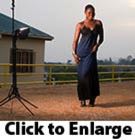Womanwise 19
19/04/10 20:40 Filed in: Technique
This was my second opportunity to photograph Kenisha Thom. The first came when I was in Tobago recording last year’s Great Fete Weekend and The Bridge publisher Chenier Belgrave asked me to schedule a session with Kenisha and her family.
 I should note that I’d packed strategically for Great Fete, working with gear and backup gear built around using an extended strobe that I’d be waving around on what might technically be described as a “stick” actually the top two extensions of an old PIC lightstand to model light in an event that might technically be described as “wildness.”
I should note that I’d packed strategically for Great Fete, working with gear and backup gear built around using an extended strobe that I’d be waving around on what might technically be described as a “stick” actually the top two extensions of an old PIC lightstand to model light in an event that might technically be described as “wildness.”
So that’s what I had for the shoot, along with a small light modifier I’d packed as a nervous afterthought.
Those photos turned out pretty well, in spite of the fact that after posing Kenisha and her family artfully on a neighbour’s hammock, attractively slung between two trees with really radiant light spilling all around it, the whole thing collapsed, mercifully harming nothing but my reputation.
For this return engagement, Kenisha politely but unequivocally declined any notion of showing the scars from the brutal attack she suffered in Tobago, which was to be the subject of the story.
The photo opportunity would take place at her Santa Margarita home, so I packed gear to take advantage of what I hoped might be attractive exteriors.
The housing project wasn’t finished and punishing heat and dry weather conditions had turned the struggling lawns a quite distinctive shade of brown. The sunset, which I planned to shoot into, also joined in, offering an image shattering background in shades of dull gray.
 I pressed into service the new Cactus radio triggers that I’d bought to fill in a small but notable gap in my location shooting capabilities.
I pressed into service the new Cactus radio triggers that I’d bought to fill in a small but notable gap in my location shooting capabilities.
I use radio slaves in the studio and on commercial shoots, but neither of these solutions work with the kit I use for my personal work, a pair of Canon strobes. Much of the work I do with this gear is handily accomplished using Canon’s STE2 infrared trigger, which supports ETTL control of the two strobes, but a light based triggering solution is utterly stymied by even moderately bright outdoors light and distances beyond 16 feet or so and any position that loses line of sight with the trigger.
Not a problem indoors, where the infrared signal can bounce around a bit, but outdoors, getting that synchronisation can be a bit like threading a needle with wicketkeeper’s gloves on.
I don’t do enough small strobe work outdoors to justify the pricier and, it’s said, more reliable units, and the Cactus triggers, which I sourced from Cowboy Studio, seem to offer terrific value for the price.
The strobes trigger in manual mode, and do so reliably in my experience so far.
The full length shoot of Kenisha Thom was done on a neighbour’s lawn with two strobes staggered in height from the left. The upper strobe is at just over quarter power, the lower one, meant to light but also to taper off the former model’s tall frame was set at just under quarter power.
Both strobes had CTO warming gels and Lumiquest light modifiers in place and I shot from roughly thirty feet away from the subject on the long end of a 70-200mm zoom.
 The closeup photo used on the cover reduced the lower light a bit more and angled it upward to balance the overhead light for a classic beauty light effect.
The closeup photo used on the cover reduced the lower light a bit more and angled it upward to balance the overhead light for a classic beauty light effect.
On reviewing the images, I really should have gone in the opposite direction with the warming gels and shifted the colour balance of the strobes down into a cooler blue to match the dull glow of a disappointing sunset, then an overall colour correction would have warmed up both subject and background.
Still, with a sparkling, sculpted beauty like Kenisha before the lens, there’s a limit to the damage my spot misjudgements could do to a photo of a two time beauty contestant.

So that’s what I had for the shoot, along with a small light modifier I’d packed as a nervous afterthought.
Those photos turned out pretty well, in spite of the fact that after posing Kenisha and her family artfully on a neighbour’s hammock, attractively slung between two trees with really radiant light spilling all around it, the whole thing collapsed, mercifully harming nothing but my reputation.
For this return engagement, Kenisha politely but unequivocally declined any notion of showing the scars from the brutal attack she suffered in Tobago, which was to be the subject of the story.
The photo opportunity would take place at her Santa Margarita home, so I packed gear to take advantage of what I hoped might be attractive exteriors.
The housing project wasn’t finished and punishing heat and dry weather conditions had turned the struggling lawns a quite distinctive shade of brown. The sunset, which I planned to shoot into, also joined in, offering an image shattering background in shades of dull gray.

I use radio slaves in the studio and on commercial shoots, but neither of these solutions work with the kit I use for my personal work, a pair of Canon strobes. Much of the work I do with this gear is handily accomplished using Canon’s STE2 infrared trigger, which supports ETTL control of the two strobes, but a light based triggering solution is utterly stymied by even moderately bright outdoors light and distances beyond 16 feet or so and any position that loses line of sight with the trigger.
Not a problem indoors, where the infrared signal can bounce around a bit, but outdoors, getting that synchronisation can be a bit like threading a needle with wicketkeeper’s gloves on.
I don’t do enough small strobe work outdoors to justify the pricier and, it’s said, more reliable units, and the Cactus triggers, which I sourced from Cowboy Studio, seem to offer terrific value for the price.
The strobes trigger in manual mode, and do so reliably in my experience so far.
The full length shoot of Kenisha Thom was done on a neighbour’s lawn with two strobes staggered in height from the left. The upper strobe is at just over quarter power, the lower one, meant to light but also to taper off the former model’s tall frame was set at just under quarter power.
Both strobes had CTO warming gels and Lumiquest light modifiers in place and I shot from roughly thirty feet away from the subject on the long end of a 70-200mm zoom.

On reviewing the images, I really should have gone in the opposite direction with the warming gels and shifted the colour balance of the strobes down into a cooler blue to match the dull glow of a disappointing sunset, then an overall colour correction would have warmed up both subject and background.
Still, with a sparkling, sculpted beauty like Kenisha before the lens, there’s a limit to the damage my spot misjudgements could do to a photo of a two time beauty contestant.
blog comments powered by Disqus